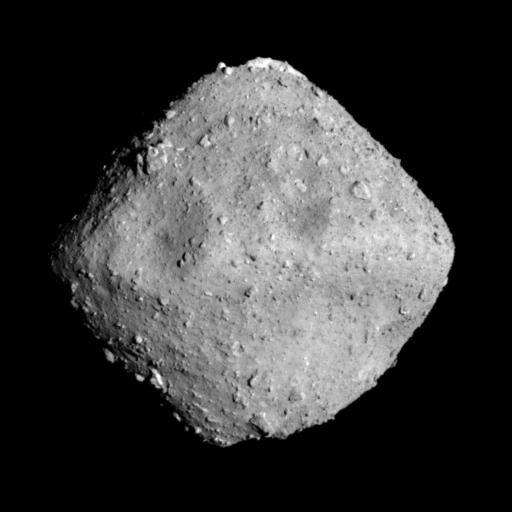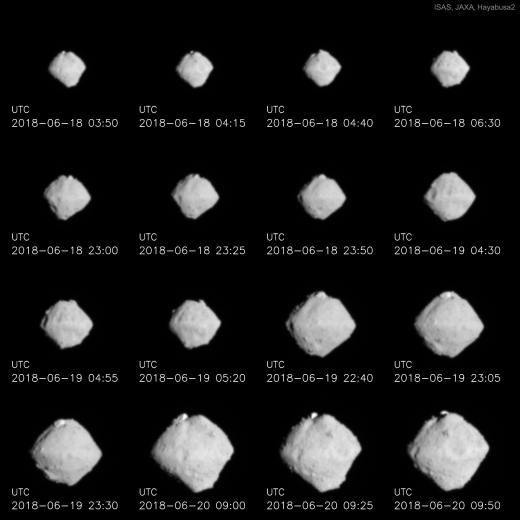The asteroid game is heating up. The Japanese probe Hayabusa 2 has arrived at asteroid 162173 Ryugu, the plan being to reach the surface with landers later this year and bring back samples in 2020. We also have ORISIS-REx, launched in 2014, on course to 101955 Bennu in December, with a sample return planned for 2023. Assuming both missions are successful, scientists will have the opportunity to compare the composition of the two. Both are C-type (carbonaceous) asteroids, darker than previously explored asteroid Itokawa. The current Hayabusa is similar to the probe that first returned an Itokawa sample to Earth in 2010.
JAXA confirmed the arrival of Hayabusa 2 at 9:35 (Japan time) on the 27th: “The National Research and Development Corporation Japan Aerospace Exploration Agency (JAXA) announces that we have confirmed the arrival at asteroid Ryugu (Ryugu) of the asteroid explorer ‘Hayabusa 2′”, adding that the distance between the spacecraft and the asteroid is about 20 kilometers.
From a JAXA statement:
The confirmation of the Hayabusa2 rendezvous made at 9:35 a.m. (Japan Standard Time, JST) is based on the following data analyses:
* The thruster operation of Hayabusa2 occurred nominally
* The distance between Hayabusa2 and Ryugu is approximately 20 kilometers
* Hayabusa2 is able to maintain a constant distance to asteroid Ryugu
* The status of Hayabusa2 is normal
Itokawa is an S-type asteroid, so this will be our first chance to sample a C-type, the closest previous encounter with the latter being the NEAR Shoemaker flyby of 253 Mathilde in 1997, which could not close to less than 1000 kilometers. Hayabusa 2 has already released an image of Ryugu from about 40 kilometers out. I liked the way project manager Yuichi Tsuda described the boulder-filled object:
“The shape of Ryugu is now revealed. From a distance, Ryugu initially appeared round, then gradually turned into a square before becoming a beautiful shape similar to fluorite [known as the ‘firefly stone’ in Japanese]. Now, craters are visible, rocks are visible and the geographical features are seen to vary from place to place. This form of Ryugu is scientifically surprising and also poses a few engineering challenges.”

Image: Closing on destination. This is asteroid 162173 Ryugu from a distance of roughly 40 kilometres. The image was taken by the spacecraft’s ONC-T (Optical Navigation Camera – Telescopic) on June 24, 2018 at around 00:01 JST. Credit : JAXA, University of Tokyo, Kochi University, Rikkyo University, Nagoya University, Chiba Institute of Technology, Meiji University, Aizu University, AIST.
I like the idea of a ‘firefly stone,’ and also note that the name Ryugu means ‘dragon’s palace’ in Japanese, giving the imagination plenty to play with. The science payoff from both Ryugu and Bennu could be significant. C-type asteroids are intriguing because they are assumed to be the source of carbonaceous chondrite meteorites and are thought to contain organic material as well as water. With a diameter of about 900 meters and a low-reflectance surface, Ryugu may not win any beauty contests, but it is conceivable that asteroids like this could be sources of water or oxygen that future space missions will tap.
Moreover, asteroids like these are expected to give us insights into objects in the early Solar System, and the samples gained by Hayabusa 2 and its landers should be able to tell us whether the asteroid’s dark surface is as rich in carbon as we assume. Of particular interest is the question of water. The isotopic and chemical analysis of Ryugu should help us gain insights into the formation of Earth’s oceans through incoming asteroids or comets. Landing site selection will be critical as the mission teams plans a 30 cm per second touchdown in October.
Tsuda goes on to note some of the challenges the early imaging is beginning to reveal. While the rotation axis of the asteroid is perpendicular to its orbit, there is a peak near the equator and various small craters, factors that will have to be considered as landing sites are assessed. The object’s unusual shape also introduces some issues:
Globally, the asteroid also has a shape like fluorite (or maybe an abacus bead?). This means we expect the direction of the gravitational force on the wide areas of the asteroid surface to not point directly down. We therefore need a detailed investigation of these properties to formulate our future operation plans.

Image: It looks like a big space diamond — but with craters. It’s 162173 Ryugu (Dragon’s Castle), and Japan’s robotic Hayabusa 2 mission is now arriving at this near-Earth asteroid. Ambitious Hayabusa 2 is carrying an armada of separable probes, including two impactors, four small close-proximity hoverers, three small surface hoppers, and the Mobile Asteroid Surface Scout (MASCOT) which will land, study, and move around on Ryugu’s surface. Most of these are equipped with cameras. Moreover, Hayabusa 2 itself is scheduled to collect surface samples and return these samples to Earth for a detailed analysis near the end of 2020. Pictured, a series of approach images shows features suggestive of large boulders and craters. Credit & Copyright: ISAS, JAXA, Hayabusa 2 Team.
Hayabusa 2’s distance from Earth is now 1.9 AU, with a round-trip light time of 1895 seconds.



The Planetary Society blog has these very useful posts on the Hayabusa 2 Ryugu mission:
http://www.planetary.org/blogs/emily-lakdawalla/2018/0627-hayabusa2-arrived-at-ryugu.html
http://www.planetary.org/blogs/emily-lakdawalla/2018/0621-hayabusa2-update-new-views.html
http://www.planetary.org/blogs/emily-lakdawalla/2018/0525-keep-up-with-hayabusa2.html
Can I assume the airlock/entry is on the far side? ;)
I am pretty sure this first one does not have a hatch, but I would not want to go near the second one…
http://memory-alpha.wikia.com/wiki/Balok%27s_cube
http://memory-alpha.wikia.com/wiki/Borg_Queen's_vessel
Stirling scientist in major international space mission
27 June 2018
A University of Stirling scientist is set to begin analysing – and attempting to recreate – conditions on a primitive asteroid as part of a major international space mission led by the Japanese.
Dr Axel Hagermann, Associate Professor in Biological and Environmental Sciences, will spend the coming months assessing data from the Hayabusa2 mission – which is aiming to learn more about the origin and evolution of the solar system – after it entered into orbit around Ryugu earlier today [June 27].
Discovered in May 1999, Ryugu is a primitive, C-type asteroid – meaning its composition includes water and organics – and is part of the Apollo group of asteroids, regarded as potentially hazardous due to their close proximity to Earth.
Hayabusa2 is the first mission to an asteroid of this nature and only the second ever to return a sample from an asteroid, and experts believe it will provide an important insight into conditions in the early solar system.
Dr Hagermann – the only UK-based scientist on the mission – is co-investigator on the Thermal Infrared Imager, which will study the temperature and thermal inertia of the asteroid. He will also help analyse data from a radiometer on the German-built lander, Mobile Asteroid Surface Scout (MASCOT), and use this information to recreate the exact conditions of the asteroid surface in the Planetary Ices Laboratory at Stirling.
Dr Hagermann, a geophysicist who focuses on ice and its physical properties, explained: “As thermal measurements on an asteroid are very tricky, this approach allows us to ensure that the thermal measurements can be interpreted as accurately as possible.
“Thermal data from the asteroid surface are important because they allow us to constrain the surface material’s physical properties, confirm erosion – such as thermal cracking of rocks – and even explore minute changes in an asteroid’s orbit due to the way it re-radiates heat into space.”
Full article here:
https://www.stir.ac.uk/news/2018/06/stirling-scientist-in-major-international-space-mission/
“The confirmation of the Hayabusa2 rendezvous made at 9:35 a.m. …”
by what criteria is “rendezvous made ” defined ??
It’s a <a href="Borg Cube Ship !</a
What would it be like to stand on the surface of Ryugu?
http://www.syfy.com/syfywire/what-would-it-be-like-to-stand-on-the-surface-of-ryugu
To quote:
But, as I pointed out in my previous post, Ryugu is a fast rotator, spinning once every 7.5 hours or so. That’s important! If you’re on a spinning object there’s an acceleration (called centripetal acceleration) that you feel as a force pushing you away from the center of the spin. It’s the same thing as when you’re in a car making a turn and you feel a force in the direction opposite the turn (if you turn left you’re thrown right, which is the same as saying you want to go straight but the car turning left makes it feel as if you’re being pushed to the right).
This counteracts the force of gravity down, toward the center of Ryugu. I played with the math a bit, and found that on the equator the force outward is about 1/5th or so of gravity! So you’d weigh noticeably less on the equator than you would at the poles just because of this.
If you’re not on the equator, that force outward points at an angle away from the center of Ryugu. The net effect is it would feel like you’re standing on a slope, downhill toward the equator, even if the ground were perfectly flat! So if you’re a rock sitting on Ryugu halfway between the equator and pole, say, and there’s a small impact by another asteroid, the ground would shake, dislodging you, and you’d roll toward the equator.
I strongly suspect that’s why Ryugu has the shape it does. Stuff has rolled “downhill” toward the equator, piling up there, forming that ridge all the way around, giving it a more diamond-like shape than spherical. If it’s a rubble pile, there’s a lot of loose material available to do this, too. So these ideas hang together.
Closing in on Ryugu:
http://www.planetary.org/blogs/emily-lakdawalla/2018/0725-hayabusa2-closeup-on-ryugu-box-a-b-c.html
Hayabusa2 prepares to collect samples, leave Planetary Society names on Ryugu
http://www.planetary.org/blogs/jason-davis/hayabusa2-samples-names.html
Hayabusa2 Team Announces Ryugu Landing Sites, Initial Science Survey Results
http://www.planetary.org/blogs/emily-lakdawalla/2018/0824-hayabusa2-team-announces-landing-site.html
Emily Lakdawalla • September 13, 2018
Hayabusa2 stops short of close approach on first touchdown rehearsal
This is why people do rehearsals. Hayabusa2 didn’t quite make it down to its intended 60-meter distance from asteroid Ryugu yesterday. The “touchdown 1 rehearsal 1” operation aborted at an altitude of about 600 meters after the laser altimeter had trouble detecting reflections from Ryugu’s very dark surface. There is nothing wrong with the spacecraft; it’s healthy and returning to its home position of 20 kilometers altitude. The team will adjust parameters and give it another try in the future. In the meantime, they grabbed some cool photos from distances under 1000 meters. The last several optical navigation photos, shared on the Web in real time, actually showed the shadow of Hayabusa2 on the surface of the asteroid.
http://www.planetary.org/blogs/emily-lakdawalla/2018/0913-hayabusa2-touchdown-1-rehearsal-1.html